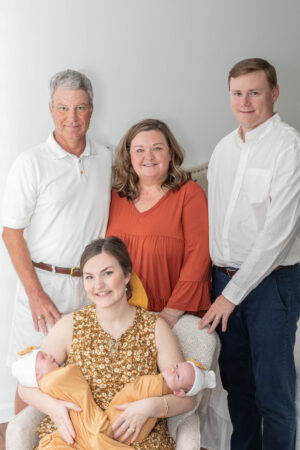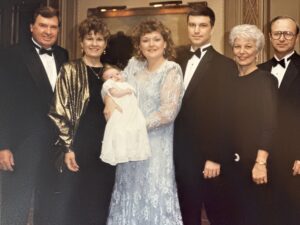Patient Stories
Leta’s Trust in Our 1988 Fertility Treatment Pays Off for Two Generations
Leta’s daughter, our 200th baby, recently had twins – without fertility treatment

In 1988 – just 10 years after the birth of the first in vitro fertilization (IVF) baby, Leta Fletcher came to The Fertility Institute of New Orleans (FINO) for fertility treatment with Dr. Curole. She and her husband, John, had been excited when she got pregnant back in 1984, but Leta miscarried. Years of struggling with infertility followed, including treatment for endometriosis (she remembers her ovaries were the size of grapefruits!), another hopeful pregnancy and another miscarriage.
Throughout 1987 she went for fertility treatments at FINO to try to regulate her LH (luteinizing hormone) levels that were “zapping” her eggs and resulting in failure of embryos to implant. Her doctor suggested that losing 20 pounds could help. “I said I would starve myself if that’s what it took to get pregnant and lost the 20 pounds,” says Leta.
She took meds to prepare for a gamete intrafallopian transfer (GIFT), which was an early fertility treatment similar to and different from IVF. GIFT involves retrieving the eggs, combining them with sperm and immediately placing them in the woman’s fallopian tubes for fertilization and pregnancy. She had the GIFT procedure on Fat Tuesday, February 16, 1988. It worked, but after nine optimistic weeks of pregnancy, ultrasound did not detect a heartbeat. Hydropic degeneration of the placenta had cut off blood flow to the baby.
Gamete intrafallopian transfer fertility treatment is an Election Day success
After removal of a cyst, her FINO doctor performed another GIFT procedure on Election Day, November 8, 1988. About 12 days later, she was pregnant with her future daughter, Julie.
“I praised God when I learned that,” says Leta. “It’s funny that the surgery was on Election Day, because Julie has always loved politics.”
An unexpected pregnancy complication: a head-on car crash
At 27 weeks pregnant Leta got into a head-on collision. She crawled out of the car, filled with fear. She went into early labor, the wetness in her pants causing her to think she’d lost the baby. Her husband rushed to the scene and drove her to the hospital because he could get there faster than an ambulance.
She was able to keep Julie in for 10 more weeks before undergoing an emergency c-section at 37 weeks along. Julie was born with bruises after the trauma she had endured, but she was alive.
Black-tie affair to celebrate her miracle baby

Julie was FINO’s 200th baby and was welcomed into New Orleans with a black-tie affair at Crowne Plaza. Doctors from across America were there to celebrate with the family. After everything they went through, little Julie was such a miracle.
Julie Fletcher has a brick in the French Quarter leading up to the aquarium. It has #200 on it.
Leta says her journey to have Julie was definitely difficult. “The hardest part was the stress it puts on your relationship,” she recalls. “All the things that happen can be so heartbreaking. The tests and procedures were tough as they added up, as well as the miscarriages.”
Related Reading: Does Stress Affect Fertility?
She was not through with children, however, and was able to conceive naturally after having Julie. After she became pregnant, the providers at The Fertility Institute followed her for 15 weeks, just to make sure everything went well. It did, and Julie soon had a little brother named Jack.
Faith in God and the future of reproductive medicine
Leta believes God gave her so many opportunities and chances where others haven’t had them and is very thankful for that.
“But don’t just say if it doesn’t happen it’s not meant to be. At least go and see what is out there, what you can do with the help of today’s technology and medical science,” she advises. “Who knows what the future of medicine holds for fertility?”
Our 200th baby has babies – without fertility treatment!
Julie heard the story of her mother’s fertility struggles all her life and assumed she would have the same struggle her mother did having a child. She and her husband, Jonathan, decided to start trying to become pregnant when Julie was 31, but not before a fun family trip.
Julie wanted to get her body in shape, more for the upcoming vacation to Hawaii than for pregnancy. Through workouts and cutting out gluten, caffeine, alcohol and dairy, she lost about 20 pounds – same as her mother had.
She didn’t realize she was preparing her body for pregnancy until reading “What to Expect Before You’re Expecting,” which, funny enough, she didn’t begin reading until she was about to take her first pregnancy test. She had unknowingly been prepping her body for her babies, and when that test came back positive, Julie was so glad her body was healthy.
Her mom came to town and went to the doctor with Julie for her first ultrasound visit as her husband was unable to go. “It was cool to have mom present when I saw the babies on the ultrasound,” says Julie. They Facetimed her husband from the room. She showed him Baby A then asked if he wanted to see the other. He thought she meant another picture until she said, “No, the other baby.” Jonathan was very surprised to learn they were going to have twins. She gave birth on September 1, 2021, to Baby A, Fletcher Ann, and Baby B, June Alexander.
Julie advises others to have faith that it will all work out and to lean into the people you know best. “If my parents hadn’t believed in fertility medicine, I wouldn’t be here and neither would my girls,” says Julie. “Maintain the faith component that is important to you but lean on the medical side as well.”
